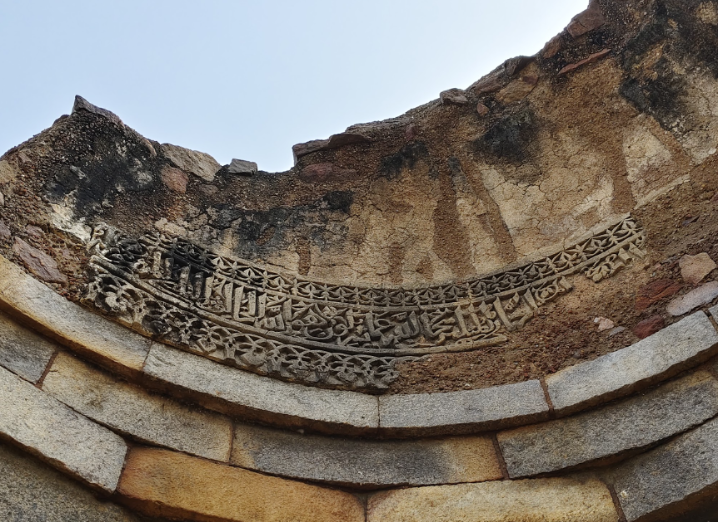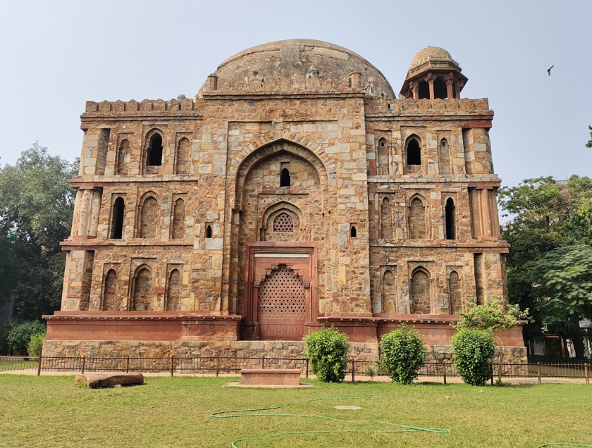Exploring Delhi’s Hidden Tombs: A Tour of Kotla Mubarakpur by Aanya Agarwal
Exploring Delhi's history is like peeling an onion. Peeling off each layer is accompanied by a growing anticipation of recovering the lost heritage. It involves a little bit of crying (read: encountering closed historical sites after painstakingly finding them!), followed by an immense sense of happiness on finding what is beneath.
It was a fine day in October, a month that is blessed with just the right amount of sun and cold. My father and I, taking advantage of the weather, decided to embark on a tomb-hopping adventure in the bustling neighbourhood of East Kidwai Nagar in South Delhi. Our mission, akin to catching Pokémons, was to spot as many tombs as we could in the Kotla Mubarakpur complex. Armed with appropriate footwear (good luck to anyone attempting to navigate the narrow lanes of Kotla Mubarakpur with a car) and a trusty phone camera, we set out on a day full of site covers!
Our journey began with Darya Khan's tomb. Newly built residential complexes and a manicured garden, packed with joggers, surround the tomb of Darya Khan. Built in the early 16th century CE, the tomb belongs to Darya Khan Lohani, who served as the chief justice, and, later, a minister during the Lodi dynasty (mid 15th to early 16th Century CE). I had been to this tomb several times alone before, drawn by the unique architecture that differentiated it from other Lodi-era tombs. The tomb has been built on a raised platform, which can be accessed through steps on the eastern side. The platform consists of four pavilions with 12-pillared domes (chattris), one in each corner. The cenotaph rests on a raised circular platform in the middle, now covered by grass on all sides. Glad that my visit this time was not marked by pairs of lovers perched on all corners of the tomb, I could look at the Quranic inscriptions, etched on the interior of the domes, properly. The domes were mostly damaged which made it difficult to read the inscriptions.
 |
| Quranic inscriptions inside one of the domes of Darya Khan's Tomb |
The site cover day started out well. Or so we thought. The very next moment, we were transported from the spacious green grounds to congested narrow lanes. It was the teamwork between us and Google Maps that helped us locate the tomb of Mubarak Shah amidst a sea of people and honking scooters. Mubarak Shah (1421 to 1434 CE) was a ruler of the Sayyid dynasty, who met a tragic end at the hands of his own ministers. It is very interesting that his tomb, sadly, has also been pushed into oblivion. An eerie reminder of the courtly betrayals, the tomb can barely be spotted in the mass of buildings. Urbanisation and unregulated construction has engulfed the monument on all sides. The encroached nature of the site presented another challenge: averting the suspicious stares of the people living inside the tomb. While access to the site was restricted, I did manage to spot an image of a Hindu deity inside the tomb structure. The image was a reminder of the many lives and uses that a monument is subjected to.
 |
| Encroachment near Mubarak Shah's Tomb |
Exiting the crowded streets, we found ourselves in yet another public park. This time, we found not one but two tombs! The tombs of Bade Khan and Chote Khan greeted us in the middle of the park. Bade Khan's tomb is larger and more elaborate, befitting the name (bade means big), while Chote Khan's tomb was comparatively modest in size. Not much is known about these figures other than the fact that they lived during the Lodi period. The easy journey to the tombs, however, did not mean that we got access to the inner chambers of both the tombs. Cue in: standing on tiptoes and stretching at interesting angles just to get a decent look through the jaali windows. The few standing chattris on the roofs of both tombs indicated that chattris would have adorned all corners of both roofs. While the origins of these tombs remain somewhat mysterious, their serene ambiance filled me with calm.
 |
| Bade Khan's Tomb |
 |
| Chote Khan's Tomb |
After encountering four tombs, one would think that would be the end of the adventure. However, you forget that Delhi is scattered with relics of past. We had only peeled a fraction of East Kidwai Nagar's layers, a fact that became clear when we stood in front of Kale Khan's tomb. Located near the South Extension market, Kale Khan's tomb probably served as the tomb of Mubarak Khan Lohani. It remains unknown as to why the tomb is called Kale Khan. Perhaps, the blackened exterior due to pollution resulted in this name.
The curse of locked sites struck us once again. I repeated the ritual of stretching, secretly hoping that my body's flexibility would improve greatly by the end of the site covers. The tomb is made on a square plan, with some attributing the structure as one of the earlier Lodi-era tombs. Unfortunately, this structure, vital in charting the development of Lodi style of architecture, was shrouded in broken glass, discarded cigarette boxes, and plastic packets.
 |
| The blackened façade of Kale Khan's Tomb |
Our final stop was the Bhure Khan's tomb, where we were greeted with the lovely 'No Entry' sign. Bhure Khan, another elusive courtier of the Lodi dynasty, rests behind the locked gates. This time, the difficulty level of accessing the site increased greatly. The surroundings were turned into a garbage dumping ground, making it difficult to even have a closer look at the tomb. I was not going to give up, and, so, I closed my nose with one hand and took the brave step forward. Bhure khan's tomb was the smallest out of all the tombs we covered that day. My father and I went around the structure and tried to observe it as much as we could.
While doing so, we stumbled across two locals near the northern wall of the tomb. A conversation was started that ultimately led to an interesting secret fact about the structure. Turns out, there is indeed a way to easily go inside the tomb despite the locked gate. One just had to pull aside the tarpaulin covering a part of the northern wall, and, lo and behold, a secret entrance greeted you! This was the only way kids in the neighbourhood occasionally accessed the site as the tomb was otherwise closed to the public. Maybe the adventurous (and equally dangerous!), wall-climbing way of accessing the tomb is the reason why the structure was in a decent condition!
The present condition of the tombs is a mixed bag. Some, like Darya Khan's tomb, retain a semblance of their former glory. Others, such as Mubarak Shah's tomb, are struggling against the ravages of time and neglect. Yet, they are alive in their own way: used by locals as parks and playgrounds. This duality of decay and reinvention is what makes heritage sites so fascinating! If you are up for a walk through the lanes of Delhi (with a dose of Google Maps-induced detours), then Kotla Mubarakpur is the perfect place to dive into an interesting period of Delhi's story.

This comment has been removed by the author.
ReplyDeleteReally loved your blog, Aanya. The way you've highlighted the rich architectural history of Delhi is both engaging and beautifully articulated. The narrative was not only compelling but also detailed, transporting me to the narrow lanes of East Kidwai Nagar and making me feel like I was experiencing it myself.
ReplyDeleteWhat an amazing read! Quite humorous and full of puns!
ReplyDelete